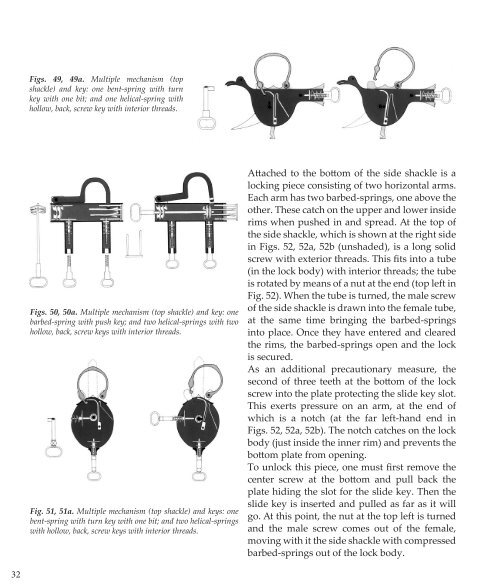Persian Locks: 1500 Years of Iranian Padlocks
In Iran, the padlock was developed in an amazing variety of sizes, shapes, materials, and mechanisms, the likes of which are less frequently encountered in Europe. On the whole, very little attention has been devoted to the history and development of the lock in Iran. Parviz Tanavoli, Iran's leading sculptor, was first attracted to the locks of his own country because of their sculptural qualities. In this beautiful and informative book the author shares with us, in over 500 photos and drawings, the most interesting examples of locks from his famous collection which was first introduced to the American public by the Smithsonian Institute on the occasion of the American Bicentennial. You will also find detailed drawings which clearly illustrate the workings of the various locking mechanisms (e.g., barbed-spring, helical-spring, notched-shackle, hook and revolving catch, etc.) used in the locks in this book. All locks are dated and when known, the place of manufacture is given. A smaller version of this updated and expanded book was published by The Smithsonian Institution in 1976 with the title, "Locks from Iran: Pre-Islamic to Twentieth Century." In 2019 and 2020 the author edited his original book adding new text and a great number of new high-quality photos of locks which have been added to his collection in the 44 years since the first book was published. Hardcover, 144 pages, 10-inches x 8.5-inches, over 500 photos and drawings.
In Iran, the padlock was developed in an amazing variety of sizes, shapes, materials, and mechanisms, the likes of which are less frequently encountered in Europe. On the whole, very little attention has been devoted to the history and development of the lock in Iran.
Parviz Tanavoli, Iran's leading sculptor, was first attracted to the locks of his own country because of their sculptural qualities. In this beautiful and informative book the author shares with us, in over 500 photos and drawings, the most interesting examples of locks from his famous collection which was first introduced to the American public by the Smithsonian Institute on the occasion of the American Bicentennial. You will also find detailed drawings which clearly illustrate the workings of the various locking mechanisms (e.g., barbed-spring, helical-spring, notched-shackle, hook and revolving catch, etc.) used in the locks in this book. All locks are dated and when known, the place of manufacture is given.
A smaller version of this updated and expanded book was published by The Smithsonian Institution in 1976 with the title, "Locks from Iran: Pre-Islamic to Twentieth Century." In 2019 and 2020 the author edited his original book adding new text and a great number of new high-quality photos of locks which have been added to his collection in the 44 years since the first book was published.
Hardcover, 144 pages, 10-inches x 8.5-inches, over 500 photos and drawings.
Create successful ePaper yourself
Turn your PDF publications into a flip-book with our unique Google optimized e-Paper software.
Figs. 49, 49a. Multiple mechanism (top<br />
shackle) and key: one bent-spring with turn<br />
key with one bit; and one helical-spring with<br />
hollow, back, screw key with interior threads.<br />
Figs. 50, 50a. Multiple mechanism (top shackle) and key: one<br />
barbed-spring with push key; and two helical-springs with two<br />
hollow, back, screw keys with interior threads.<br />
Fig. 51, 51a. Multiple mechanism (top shackle) and keys: one<br />
bent-spring with turn key with one bit; and two helical-springs<br />
with hollow, back, screw keys with interior threads.<br />
Attached to the bottom <strong>of</strong> the side shackle is a<br />
locking piece consisting <strong>of</strong> two horizontal arms.<br />
Each arm has two barbed-springs, one above the<br />
other. These catch on the upper and lower inside<br />
rims when pushed in and spread. At the top <strong>of</strong><br />
the side shackle, which is shown at the right side<br />
in Figs. 52, 52a, 52b (unshaded), is a long solid<br />
screw with exterior threads. This fits into a tube<br />
(in the lock body) with interior threads; the tube<br />
is rotated by means <strong>of</strong> a nut at the end (top left in<br />
Fig. 52). When the tube is turned, the male screw<br />
<strong>of</strong> the side shackle is drawn into the female tube,<br />
at the same time bringing the barbed-springs<br />
into place. Once they have entered and cleared<br />
the rims, the barbed-springs open and the lock<br />
is secured.<br />
As an additional precautionary measure, the<br />
second <strong>of</strong> three teeth at the bottom <strong>of</strong> the lock<br />
screw into the plate protecting the slide key slot.<br />
This exerts pressure on an arm, at the end <strong>of</strong><br />
which is a notch (at the far left-hand end in<br />
Figs. 52, 52a, 52b). The notch catches on the lock<br />
body (just inside the inner rim) and prevents the<br />
bottom plate from opening.<br />
To unlock this piece, one must first remove the<br />
center screw at the bottom and pull back the<br />
plate hiding the slot for the slide key. Then the<br />
slide key is inserted and pulled as far as it will<br />
go. At this point, the nut at the top left is turned<br />
and the male screw comes out <strong>of</strong> the female,<br />
moving with it the side shackle with compressed<br />
barbed-springs out <strong>of</strong> the lock body.<br />
32










